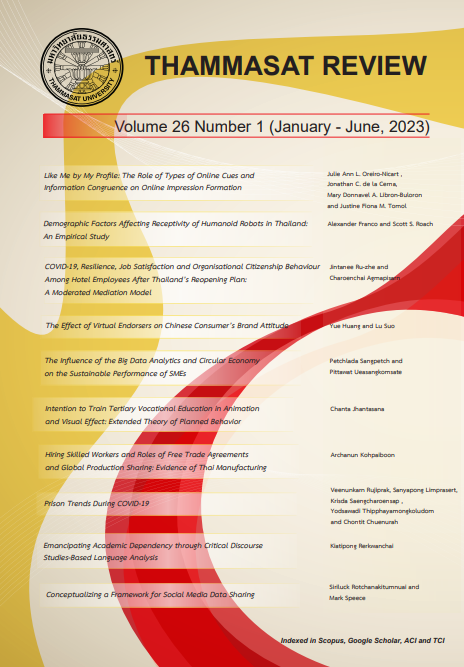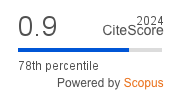Hiring Skilled Workers and Roles of Free Trade Agreements and Global Production Sharing: Evidence of Thai Manufacturing
Keywords:
Global Production Sharing (GPS), Trade liberalization, Free Trade Agreement (FTA) Skilled workers, Thai ManufacturingAbstract
The paper examines the extent to which firms hire skilled workers with a view to informing two policy debates about ongoing economic globalization, i.e. the impact of trade liberalization under free trade agreements (FTAs) and that of participating in global production sharing (GPS). Panel data econometric analysis is undertaken using a firm-level panel dataset compiled from three censuses of Thai manufacturing (2006, 2011 & 2016). Our key findings suggest that while competitive pressure from abroad is one crucial factor driving firms to be active in hiring skilled workers and staying competitive, using FTAs to create competitive pressure must be undertaken with caution as its effectiveness hinges on how their commitment has been made. Participating in GPS could influence firms to hire more skilled workers. This points to a mutual benefit to be shared across countries by participating in GPS. Enlarging the pool of skilled workforces must go hand in hand with promoting the use of skilled workers by firms to avoid worsening existing labour mismatching challenges.
References
Amiti, M., & Konings, J. (2007). Trade liberalization, intermediate inputs, and productivity: evidence from Indonesia. American Economic Review, 97(5). 1611-1638.
Antonelli, G., Antonietti, R., & Guidetti, G. (2010). Organizational Change, Skill Formation, Human Capital Measurement: Evidence from Italian Manufacturing Firms. Journal of Economic Surveys, 24(2). 206-47.
Antonioli, D., Manzalini, R., & Pini, P. (2011). Innovation, Workers Skills and Industrial Relations: Empirical Evidence from Firm-level Italian Data. Journal of Socio-Economics, 40, 312-326.
Athukorala, P. (2011). ‘Production Networks and Trade Patterns in East Asia: Regionalization or Globalization?’, Asian Economic Papers, 10(1): 65-95.
Athukorala, P., & Kohpaiboon, A. (2010). Trade and Investment Patterns in Asia: Implications for the Debate on Multilateralising Regionalis. In Kawai, M., & Baldwin, R.Multilateralizing Asian Regionalism. Oxford University Press.
Athukorala, P., & Kohpaiboon, A. (2015). Global Production Sharing, Trade Patterns and Industrialization in Southeast Asia. IN Coxhead, I. (ed.) Handbook of Southeast Asian Economies. Routledge.
Autor, D., Katz, L., & Kreuger, A. A. (1998). Computing inequality: Have computers changed the labor market. Quarterly Journal of Economics, 113, 1169–1213.
Balassa, B. (1965). Tariff protection in industrial countries: an evaluation. Journal of Political Economy, 73, 573-94.
Baldwin, J., & Yan, B. (2021). Globalization, productivity performance, and the transformation of the production process. Scandinavian Journal of Economics, 123(4). 1088-1115.
Bas, M., & Paunov, C. (2021). Input quality and skills are complementary and increase output quality: causal evidence from Ecuador’s trade liberalization. Journal of Development Economics, 151, 102668.
Becker, G. (1965). A Theory of the Allocation of Time. Economic Journal, 75, 493-517.
Berman, E., Bound, J., & Griliches, Z. (1994). Changes in the demand for skilled within U.S. manufacturing industries: Evidence from the annual survey of manufacturing. Quarterly Journal of Economics, 109(2). 367–397.
Blatter, M., Muehlemann, S. S., & Schenker, S. (2012). The costs of hiring skilled workers. European Economic Review, 56(1). 20-35.
Blatter, M., Muehlemann, S., Schenker, S., & Wolter, S. (2016). Hiring Costs for Skilled Workers and the Supply of Firm-provided Training. Oxford Economic Papers, 68(1). 238-57.
Caves, R. (2007). Multinational Enterprise and Economic Analysis. Cambridge University Press: Cambridge.
Caves, R. E. (1976). Economic Models of Political Choice: Canada's Tariff Structure. Canadian Journal of Economics, 9, 278–300.
Chen, B., Yu, M., & Yu. Z. (2017). Measured skill premia and input trade liberalization: evidence from Chinese firms. Journal of International Economics, 109, 31-42.
Corden, W. M. (1966). The structure of a tariff system and the effective protective rate. Journal of Political Eocnomy, 74(3). 221-37.
Ejarque, J. M., & Nilsen, O. A. (2008). Identifying Adjustment Costs of Net and Gross Employment Changes. IZA Discussion Paper 3703.
Feenstra, R. (2004). Advanced International Trade: Theory and Evidence, Princeton, N.J.: Princeton University Press.
Fieler, A. C., Eslava, M., & Xu, D.Y. (2018). Trade, quality upgrading, and input linkages: theory and evidence from Colombia. American Economic Review, 108(1), 109–146.
Flug, K., & Hercowitz, Z. (2000). Equipment investment and the relative demand for skilled labor: international evidence. Review of Economic Dynamics, 3, 461-485.
Gonzalez-Garcia, J., & Yang, Y. (2022). The effect of trade on market power: evidence from developing economies. Journal of International Trade and Economic Development, 31(6), 811-834
Greenaway, D., Hine, R. C. & Wright, P. (1999). An Empirical Assessment of the Impact of Trade on Employment in the United Kingdom. European Journal of Political Economy, 15(3), 485–500.
Griliches, Z. (1969). Capital-skill complementarity. Review of Economics and Statistics, 51(4). 251–266.
Hallak, J. C., & Sivadasan, J. (2013). Product and process productivity: implications for quality choice and conditional exporter premia. Journal of International Economics, 91(1). 53–67.
Harris, R., & Robertson, P. (2013). Trade, wages and skill accumulation in the emerging giants. Journal of International Economics, 89, 407-421.
Herrera, E. (2013). Comparing Alternative Methods to Estimate Gravity Model of Bilateral Trade. Empirical Economics, 44(3), 1087-1111.
Hine, R. C., & Wright, P. (1997). Trade and Manufacturing Employment in the United Kingdom. In Borkakoti, J., & Milner, C. (eds.) International Trade and Labor Markets. Palgrave Macmillan.
Hollanders, H., & ter Weel, B. (2002). Technology, knowledge spillovers and changes in employment structure: Evidence from six OECD countries. Labour Economics, 9, 579–599.
Jongwanich, J. (2022). The Economic Consequence of Globalization on Thailand, Routledge, London.
Jongwanich, J., & Kohpaiboon, A. (2015). Multinational Enterprises, Exporting and R&D Activities in the South. Thailand and the World Economy, 33(2), 1-54, http://www. econ.tu.ac.th/oldweb/doc/article/fulltext/360.pdf
Kano, L., Tsang, E., & Yeung, H. (2020). Global value chains: a review of the multi-disciplinary literature. Journal of International Business Studies, 51, 577-622.
Katz, L., & Margo, R. A. (2013). Technical change and the relative demand for skilled labor: the United States in historical perspective. Paper presented at the Human Capital and History: the American Record N. B. o. E. Research. Massachusetts
Kiyota, K. (2012). A Many-cone World? Journal of International Economics, 86(2), 345–54.
Kohpaiboon, A. (2010). Product Fragmentation Phenomenon, Production Networks of Multinationals and Implication on Thai Manufacturing, Misterkopy: Bangkok, pp. 213 (in Thai).
Kohpaiboon, A., & Jongwanich, J. (2007). Determinants of Protection in Thai Manufacturing. Economic Papers, 26(3), 276-94.
Kohpaiboon, A., & Jongwanich, J. (2014). Global Production Sharing and Wage Premiums: Evidence from the Thai Manufacturing Sector. Asian Development Review, 31(2), 141-164.
Kohpaiboon, A., & Jongwanich, J. (2019). The Use of FTAs: the Thai Experience. In Ing, L., Richardson, M., & Urata, S. (eds.). East Asian Integration: Goods, Services and Investment. Routledge.
Kohpaiboon, A., & Jongwanich, J. (2020). Effectiveness of Industrial Policy on Firm Productivity: Evidence from Thai Manufacturing. Asian Pacific Economic Literature, 34(2), 39-63.
Krusell, P., Ohanina, L., Rios-Rull, J., & Vilante, G. (2000). Capital-Skill Complementarity and Inequality: A Macroeconomic Analysis. Econometrica, 68(5),1029-1053.
Kugler, M., & Verhoogen, E. (2012). Prices, plant size, and product quality. Review of Economics Studies, 79(1), 307–339.
Leamer, E., & Levinsohn, J. (1995). International Trade Theory: The Evidence. In Grossman, G., & Rogoff, K. (eds). Handbook of International Economics Vol. 3, Elsevier.
Leamer, E., & Schott, P. (2005). The Rich (and Poor) Keep Getting Richer. Harvard Business Review, 83(4), 20.
Levinsohn, J. (1993). Testing the imports-as-market-discipline hypothesis. Journal of International Economics, 35, 1-22.
Manning, A. (2006). A Generalized Model of Monopsony. Economic Journal, 116(508), 84-100.
McGowan, M. A., & Andrews, D. (2017). Labour market mismatch and labor productivity: evidence from PIAAC data. Research in Labor Economics, 45, 199-241.
Merz, M., & Yashiv, E. (2007). Labor and the Market Value of the Firm. American Economic Review, 97(4), 1419-1431.
Milner, C., & Wright, P. (1998). Modelling Labour Market Adjustment to Trade Liberalisation in an Industrialising Economy. Economic Journal, 108(447), 509–28.
Mincer, J. (1979). Schooling, Experience, and Earnings, National Bureau of Economic Research (NBER). New York.
Modestino, A., Daniel, S., & Balllance. J. (2020). Upskilling: Do Employers Demand Greater Skill When Workers Are Plentiful? Review of Economics and Statistics, 102(4), 793-805.
Muehlemann, S., & Leiser, M. (2018). Hiring cots and labor market tightness. Labour Economics, 52, 122-131.
Pavitt, K., Robson, M., & Townsend, J. (1987). The Size Distribution of Innovation in the UK: 1945-83. Journal of Industrial Economics, 35(3), 297-316.
Roberts, M., & Skoufias, E. (2007). The Long-run Demand for Skilled and Unskilled Labor in Colombian Manufacturing Plants. Review of Economics and Statistics, 79(2), 330-334.
Schneider, B. (2015). Designing Industrial Policy in Latin America: Business-Government Relations and the New Developmentalism. Palgrave.
Schumpeter, J. (1942). Capitalism, Socialism and Democracy. Harper & Brothers.
Silva, J. (2008). International trade and the changing demand for skilled workers in high-tech manufacturing. Growth and Change, 39(2), 225-251.
Silva, J. M. C. S., & Tenreyro, S. (2006). The Log of Gravity. Review of Economics and Statistics, 88(4), 641–658.
Sloane, P. and K. Mavromaras (2020). "Overeducation, skill mismatches, and labor market outcomes for college graduates." IZA World of Labor, 88(2), 1-10.
Taglioni, D., & Winkler, D. (2016). Making Global Value Chains Work for Development, World Bank, Washington.
Turkson, F. (2015). Trade Cost. In Morrissey, O., Lopez, R., & Sharma, K. (eds.). Handbook on Trade and Development, Edward Elgar.
Vaona, A., & Painta, M. (2008). Firm Size and Innovation in European Manufacturing. Small Business Economics, 30(3), 283-299.
WDR. (2020). Trading for Development in the Age of Global Value Chains. World Development Report (WDR). Washington, World Bank.
WTO. (2021). Global Value Chain Development Report. Geneva, World Trade Organization (WTO).
Yasar, M., & Rejesus, R.M. (2020). International linkages, technology transfer, and the skilled labor wage share: Evidence from plant-level data in Indonesia. World Development, 128, 104847.
Downloads
Published
How to Cite
Issue
Section
License
Copyright (c) 2023 Thammasat Review

This work is licensed under a Creative Commons Attribution-NonCommercial-NoDerivatives 4.0 International License.
The opinions and ideas expressed in all submissions published in Thammasat Review are solely that of the author(s) and do not necessarily reflect that of the editors or the editorial board.
The copyright of all articles including all written content and illustrations belong to Thammasat Review. Any individuals or organisation wishing to publish, reproduce and distribute a particular manuscript must seek permission from the journal first.








